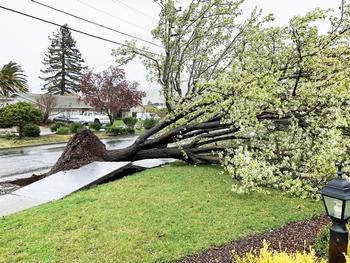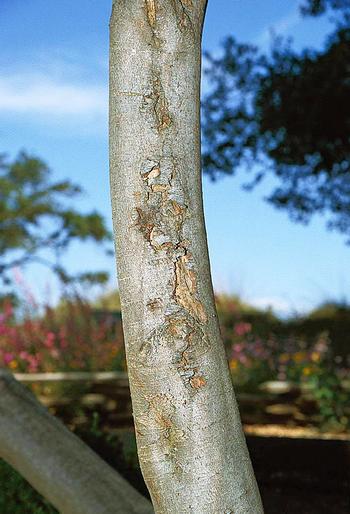Crazy weather and your trees
-
Nanette Londeree
-
Trees are all around us, standing tall and silent, doing their important work. As the biggest plants on Earth, they give us oxygen, store carbon, stabilize the soil and provide a home to wildlife. They also provide food, shade and can help reduce energy use. They do all this year in and year out, withstanding whatever Mother Nature throws at them. And this year, they were doozies!
 Cyclone force winds toppled even healthy-looking trees. Photo: Rebecca Bingea
Cyclone force winds toppled even healthy-looking trees. Photo: Rebecca BingeaConsider – a year ago; we were in the third year of drought after one of the driest winters in history. By September, high temperatures in central Marin reached 110 degrees F, with triple digits lasting five days, blistering the environment. December ushered in the first of a dozen atmospheric rivers, causing flooding and standing water in many gardens. Late February brought snow to our hilly peaks and freezing temperatures to low-lying areas. An extraordinary March included more rain and cyclone-force winds. Through all of this, our majestic trees took the brunt of it; sadly, some did not withstand it.
Hopefully, all your trees made it through the weather challenges. To be sure they're in good shape, take a closer look and check for damage or signs of stress. The abundant rain saturated the soil. If soil doesn't drain, a tree's roots can end up sitting in water for an extended period of time. This eliminates oxygen from the soil and can result in root suffocation - a serious, often life-threatening problem for plants. A short-term deficit that lasts for days can produce wilting and premature leaf drop. Lack of oxygen for weeks or longer kills roots, stunts growth, causes abnormally short shoots and small leaves and may lead to the tree's gradual decline and death. Or you may see leaves that suddenly collapse and turn brown, branches that die back from the tips. If you see any of these symptoms, check your soil and confirm it's draining adequately. Weeks after the rains stopped, standing water was found in the planting hole of tree that began showing signs of suffocation. Photo: Nanette Londeree
Weeks after the rains stopped, standing water was found in the planting hole of tree that began showing signs of suffocation. Photo: Nanette LondereeLook for areas around trees that are still visibly damp. The presence of mushrooms near the base and conks (bracket-like growths) growing on the bark of trees or on exposed roots are fruiting bodies of decay-causing fungi and indicators of root rot or wood decay.
Check for structural damage. Large trees may have "hangers" - broken branches that have not fallen from the tree. Inspect the canopy for broken branches and branches that have broken off completely and are resting on other branches.
Examine the trunk for cracks. Deep cracks indicate that a separation of the wood within a trunk or branch has occurred, and the tree has become structurally weakened. If you find a crack, it is best to contact an arborist to have it inspected. In some cases, pruning can reduce the potential hazard by lightening the load on the branch or trunk. In other cases, more extensive measures may be needed. Sunburn injury to bark increases susceptibility to wood-boring pests. Photo: Regents, University of California
Sunburn injury to bark increases susceptibility to wood-boring pests. Photo: Regents, University of CaliforniaLast summer's intense heat and solar radiation may have caused some sunburn - damage to the bark, foliage, fruit, and other aboveground plant parts. Sunburn injury to bark increases susceptibility to wood-boring pests and contributes to tree decline and premature death. It's most common in new plantings that lack a well-developed root system and where the bark is thin. In addition, older trees may be damaged when the bark is newly exposed to the sun because of pruning or premature leaf drop.
With the inclement weather now behind us, closely observe your trees in the coming weeks for any signs of damage they may have sustained. You can find information on diagnosing plant problems, improving drainage, and protecting plants from wind, sunburn, and other extreme weather on the Marin Master Gardener website, https://marinmg.ucanr.edu/. If you have any significant questions about your tree's health, consult a certified arborist. Mature trees are often a garden's most valuable asset.



